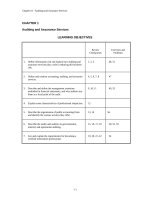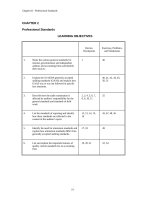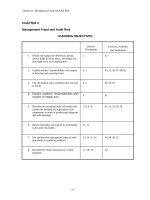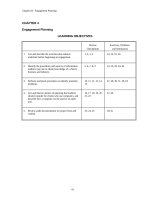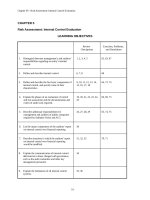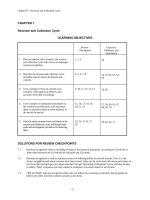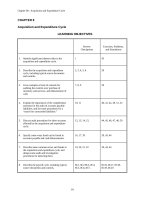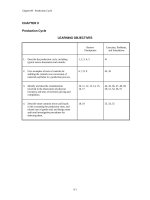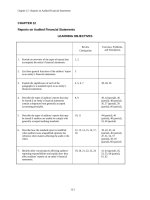Solution manual cost and managerial accounting by barfield 3rd implementing quality concepts
Bạn đang xem bản rút gọn của tài liệu. Xem và tải ngay bản đầy đủ của tài liệu tại đây (68.19 KB, 23 trang )
Chapter 8
Implementing Quality Concepts
Questions
1.
In the global economy, consumers have more choices than ever
in buying products. To successfully position its products in
this market, a company must maintain a reputation for
delivering products of high quality and high perceived value.
Accordingly, quality and value have emerged as important
competitive dimensions in many markets. Competition based on
these dimensions causes all competitors to strive to
constantly deliver more value and higher quality at a lower
price to maintain their share of the market.
2.
It is unlikely that the quality movement will fade. There is
too much competition among firms that are individually
stressing quality as a primary product or service feature. To
remain competitive, a company will have to meet the quality
standards set by others, standards that are constantly being
raised because of the increased recognition of the need for
continuous improvement.
3.
Quality refers to the dimensions or characteristics of a
product or service that make it able to meet the stated or
implied needs of the person acquiring it.
Quality can be viewed from the perspective of the
production process or through the eyes of the consumer. When
viewed from the perspective of the production process, quality
is often measured in terms of product life, failure rate, and
durability. The consumer's view of quality reflects how well
the product or service meets specified needs.
Both views of quality are valuable. The internal view of
quality leads to greater process efficiency and better product
design. The external view of quality keeps the company
focused on the needs of its customers and the relationship
between internal processes and external value.
4.
Such activities include reworking defective units, handling
waste materials, repairing broken production machinery,
replacing broken product components, and scrapping defective
products or product components.
193
194
Chapter 8
Implementing Quality Concepts
5.
Managers can hold suppliers responsible for controlling the
quality of their products. Demanding high quality inputs will
reduce the number of defective outputs. Managers can also
increase employee and managerial training, so that each
employee monitors the quality of his/her efforts. This
action will reduce the need for rework, make employees more
conscious of how their job tasks relate to quality output, and
encourage employee teamwork. A company can also upgrade
production machinery to utilize new technology that can
monitor output and reduce or eliminate mechanical mistakes.
6.
Statistical process control techniques can be used to identify
abnormal variations in a production process. Every production
process has normal and tolerable variation. Statistical
process controls can be used to identify when the variation in
the process becomes abnormal, signaling that some aspect of
the process needs to be corrected.
7.
The eight characteristics are detailed in Exhibit 8-2, page
307. They are performance, features, reliability,
conformance, durability, serviceability, aesthetics, and
perceived quality.
The five characteristics of service quality are provided
in Exhibit 8-3, page 307. They are reliability, assurance,
tangibles, empathy, and responsiveness.
The majority of the product quality characteristics are
objective, whereas the service quality characteristics are
subjective. Thus, a company’s product could be reliable but
its customer service department might not be. Product
reliability can be tested against constant company
specifications; service reliability is judged by individual
customers. As noted in the chapter, however, it is possible
for services to be measured against characteristics, if the
service is in fact defined as the “product” the company sells.
8.
Each student will have a different answer. No solution
provided.
9.
False. Consumers will purchase only those goods and services
that are perceived to be of value to them. Regardless of how
well a product is manufactured or how well it functions, it
will only be in demand if it satisfies the needs of the
market.
Chapter 8
Implementing Quality Concepts
195
10.
Each of you would probably have a different view of “high
quality,” although both you and your parents may accept
Gates’s definition. In making a residence choice, each of you
will assess residence characteristics based on the
characteristics that each of you deems necessary, desirable,
and affordable. Thus, the “grade” level of your choice may
reflect the need to be close to school because you have no
car, the need for two bedrooms because you have a roommate,
the desire to have a washer and dryer, and the price. Your
parents may put more weight on neighborhood, swimming pool,
ease of commute, and price. Bill Gates may emphasize size,
technological gadgets, and privacy.
11.
Benchmarking refers to a process of investigating, comparing,
and evaluating one company’s products or services against
those of another. Results benchmarking looks at the end
product or service and its design, components, costs, and
features. Process benchmarking looks at how something is
produced or delivered, focusing on effectiveness and
efficiency.
12.
Each student will have a different answer.
provided.
13.
In benchmarking, management identifies a firm or set of firms
that is perceived as being the best in some business aspect
(e.g., eliminating unneeded inventory). Management then
identifies ways to improve its own operations by embracing the
practices of the benchmark firm, adapting those practices to
fit the adopting firm’s characteristics, and may evaluate its
progress in that business aspect using the benchmark firm’s
practice outcomes as measurement standards.
14.
The steps are detailed in Exhibit 8-4, page 310. They are
summarized below.
1.
Determine the area in which improvements are needed.
2.
Select the quality characteristics which will measure
quality performance.
3.
Identify the benchmark companies.
4.
Ask for cooperation from the benchmark companies.
5.
Collect information.
6.
Analyze the performance gap - differences between the
firm undergoing self-examination and the benchmark firms.
7.
Identify and implement improvements.
8.
Strive for continuous improvement.
No solution
196
Chapter 8
Implementing Quality Concepts
15.
Total quality management is an organization wide effort to
seek continuous improvement in all aspects of operations. The
three tenets are:
1.
TQM necessitates an internal managerial system of
planning, controlling, and decision making.
2.
It requires participation by everyone in the
organization.
3.
It focuses on improving goods and services from the
customer's point of view.
16.
TQM is significant because it is a valuable managerial tool
that can influence business longevity and profitability. A
company that invests in TQM will produce goods or provide
services that meet customers’ expectations. Making TQM work
requires participation of everyone in the organization. TQM
requires investments in both training and technology as well
as a culture adjustment toward “doing the right things right.”
17.
No answer provided. However, most of the costs that the
students should discuss will be external failure costs
(because these will probably be the readily obtainable).
18.
The Malcolm Baldrige National Quality Award is a competition
for U.S. businesses. The award is based on an evaluation of
management systems, processes, and customer satisfaction.
There are five categories of entrants for the Baldrige
Award: manufacturing, service, small business, education, and
health care.
The award criteria categories are (see Exhibit 8-5, page
314): leadership, strategic planning, customer and market
focus, information and analysis, human resource focus, process
management, and business results.
19.
The two types of costs are costs of quality compliance and
costs of quality failure or noncompliance. Costs of
compliance include prevention and appraisal costs. Costs of
failure or noncompliance include internal failure costs and
external failure costs.
Quality is never free. Significant costs are going to be
incurred to prevent, assess, or respond to product failure. A
low failure rate may be obtained with high levels of spending
on compliance costs, and a high failure rate will result in
high spending levels on noncompliance costs. See Exhibit 8-7,
page 316, for a graphical display of these relationships.
However, the financial benefits generated by high quality
often offset the actual costs of having that level of quality,
thereby, making high quality more profitable than low quality.
Chapter 8
Implementing Quality Concepts
197
20.
Management can use the information generated from internal and
external failures to reevaluate company processes and make
decisions about future courses of action. Management may
decide to invest in new technology, additional training, or a
higher level of research and development. Employees may also
be more empowered so that, should they see a defect occur or a
way to improve a process, they may use their own judgment and
skills to handle the problem or help redesign the process.
21.
Information on quality can be obtained from quality inspection
reports, statistical control charts, customer returns and
allowances, customer complaints, and accounting records (e.g.,
warranty expense).
22.
The four time phases of quality in the production-sales cycle
are before production, during production, after production,
and after sale. There are interdependencies in which the
costs of each phase are inversely related to costs incurred in
the subsequent and prior phases. For example,
higher
spending on quality considerations before production will lead
to a decrease in spending in the later stages. Similarly,
higher spending during production will reduce quality-related
expenditures after production and after sale.
23.
Pareto analysis helps identify the areas in which managers
should focus their quality enhancement/cost reduction efforts
so as to have the greatest impact. Managers can then allocate
their time such that the amount of time invested in improving
operations can be proportional to the benefits achieved.
24.
Exhibit 8-9, page 319, displays four accounts that can be used
to capture the effects of quality control efforts. Those
accounts would fall under prevention costs (e.g., training,
market research), appraisal costs (e.g., quality inspections,
verifying procedures), internal failure costs (e.g., scrap and
waste, reprocessing), and external failure costs (e.g.,
complaints handling, warranty handling).
25.
Strategic cost management links information to corporate
strategies by allowing managers to set and communicate
organizational goals and objectives throughout the company;
establish, implement, and monitor techniques and processes;
accumulate and process measurement activities in a variety of
ways based on the needs of users; and assess activities on a
cost – benefit basis for both short-term and long-term
decision models.
26.
No solution provided.
Chapter 8
Implementing Quality Concepts
198
27.
The continuum is depicted in Exhibit 8-12, page 324. At the
low end of the continuum, a company merely meets internal
inspection standards. At the next level is ISO 9000, followed
by the Malcolm Baldrige award. At the high end of the
continuum is TQM.
28.
Standards are issued for a variety of reasons. Two primary
reasons are to ensure compatibility across systems (e.g.,
electrical plugs will be compatible with electrical outlets)
and to protect consumers. In the global marketplace, quality
may vary among the competitors in a specific market. A given
country's standards ensure a minimal level of quality for all
firms serving markets in that country.
A common set of global standards levels the playing field
for all companies and should result in lower costs to all
consumers. Companies will no longer have to incur the costs
associated with complying with a variety of country-specific
standards. The cost savings resulting from the lower
compliance costs can be passed along to consumers.
29.
The role of this organization is to develop a set of global
quality standards. The best known of these standards are the
ISO 9000 series which are detailed in Exhibit 8-13, page 327.
30.
A quality audit involves a review of product design
activities, manufacturing processes and controls, quality
documentation and records, and management quality policy and
philosophy. It is often performed in connection with the ISO
9000 registration process.
Exercises
31.
a.
b.
c.
d.
e.
f.
g.
h.
i.
j.
4
7
5
6
1
8
2
10
3
9
32.
a.
False.
b.
False. Traditional accounts have quality costs imbedded
in a variety of accounts. They are generally not
separately identifiable.
c.
True.
This definition fails to include appraisal costs.
Chapter 8
Implementing Quality Concepts
33.
199
d.
False. As the number of defective products produced
rises, both internal and external failure costs can be
expected to rise.
e.
False. Higher quality typically leads to lower costs and
greater profits in the long run.
f.
False. Total quality management requires quality to be
viewed from the perspective of the customer.
g.
False. Benchmarking can utilize comparisons to firms in
any industry.
h.
False. SPC charts are used to plot the variation in a
process so that out-of-control conditions can be
recognized.
i.
True.
j.
False. Spending on quality is unavoidable and is never
free. Firms simply have a choice to either spend on
quality compliance or quality noncompliance.
a.
Control Chart
N
u
m
b
e
r
46
44
42
40
o 38
f 36
34
s
l 32
i 30
c 28
e
0
s
4
8
12
16
20 24 28
Observation number
32
36
40
Chapter 8
Implementing Quality Concepts
200
b.
The control chart demonstrates that there is substantial
variation in the number of pepperoni slices per pizza.
Although the number of slices per pizza is
concentrated around the mid-thirties area, many of the
pizzas have more than 40 slices. If the objective is to
stay in the range of 34 to 38 slices per pizza, this
objective is not being achieved. It is also evident that
the tendency is to err in the direction of putting more
than the specified number of slices on the pizzas.
Service Characteristics
Reliability Assurance Tangibles Empathy Responsiveness
Performance
X
X
X
X
Product
Features
X
X
X
X
CharacteristicsReliability
X
X
Conformance
X
X
X
Durability
X
Serviceability
X
Aesthetics
X
X
X
Perceived quality
X
X
X
X
34.
The oral presentation should discuss the extent to which
the dimensions of quality in product production and
delivery and service provision are similar. Both have
quality dimensions concerned with the product or service
being delivered as promised, being pleasing to the
senses, having a rigorous production process, and being
defined from the user’s point of view.
35.
a.
Each party would value different characteristics of the
automobiles. The valued characteristics would depend on
the unique circumstances of each buyer. Each buyer would
place different weights on the various features
associated with alternative vehicles and the various
dimensions of quality such as size, economy, safety, and
reliability.
b.
All of the buyers would be interested in initial cost,
safety, reliability, and operating costs. The young
college student is probably also interested in style,
performance, and sound systems. The young married couple
would be interested in seating capacity (possibly a
built-in baby seat), trunk storage, safety (including
features like air bags), and warranty. The elderly
couple is probably more interested in how easy the
vehicles are to get into and out of, comfort (including
features like air conditioning), ease of maintenance, and
service and warranty provisions.
Chapter 8
Implementing Quality Concepts
36.
a.
b.
201
2002
Defect Prevention costs
Quality training
$ 9,000
Quality technology
7,500
Quality production design 4,000
Total
$20,500
$10,500
10,000
9,000
$29,500
External failure costs
Warranty handling
$15,000
Customer reimbursements
11,000
Customer returns handling 7,000
$33,000
$10,000
7,200
4,000
$21,200
-
33%
35%
43%
36%
Total
$50,700
-
5%
$53,500
2003
% change
17%
33%
125%
44%
The pattern of change in quality costs appears to be very
favorable. Total expenditures for quality costs declined
from 2002 to 2003. Perhaps most importantly, the
internal quality compliance costs rose and the
noncompliance costs declined. This pattern of change
should allow the perception of quality by customers in
the firm’s products to rise. Customers will detect fewer
defective products and require fewer repair and
replacement services.
37.
a. b.
Compliance Costs
1. Fitting machines for mistake-proof operations
2. Supply-line management
3. Quality training
Noncompliance Costs
4. Customer refunds for poor product quality
5. Disposal of waste
6. Litigation claims
Total
c.
2002
$ 9,400
8,000
28,000
$45,400
24,000
$ 44,000
72,000
$140,000
$185,400
2003
$13,800
10,000
30,000
$53,800
18,000
$36,000
56,000
$110,000
$163,800
%Change
+47%
+25%
+ 7%
+20%
-25%
-18%
-22%
-21%
-12%
A 20% increase in compliance cost was accompanied by a 21%
decrease in noncompliance cost and an overall reduction in the
costs of quality. Management seems to be effectively managing
costs of quality. The pattern of change is consistent with
quality-conscious management. The costs incurred for
compliance have increased from 2002 to 2003 creating a
favorable effect: a decrease in the costs of noncompliance.
Thus, the company is spending more to prevent quality problems
and spending less to treat quality problems.
Chapter 8
Implementing Quality Concepts
202
38.
39.
40.
a.
Profits lost by selling defective units
(3,000 - 600) × ($30 - $20) = 2,400 × $10 =
$24,000
b.
Profits lost by selling defective units
Rework costs (600 × $6)
Cost of warranty work
Cost of customer returns (200 × $5)
Total costs of failure
$24,000
3,600
2,500
1,000
$31,100
c.
Total costs of failure
Prevention costs
Appraisal costs
Total quality costs
$31,100
25,000
6,800
$62,900
a.
Cost to rework
b.
Lost profit from not reworking all defective units
(290 - 190) × ($28 - $10) = 100 × $10 = $1,800
c.
Cost of customer returns
50 × $5 = $250
d.
Total failure costs are the sum of the answers to a, b,
and c.
$1,520 + $1,800 + $250 = $3,570
e.
Total failure costs
Prevention costs
Appraisal costs
Total quality cost
a.
The prevention costs would increase because that category
would reflect the depreciation and operating costs of the
equipment. However, both the internal and external
failure costs would decline because of a lower level of
defective output. Appraisal costs might also decline if
the company can place greater confidence in output
quality because of the new machine and thereby conduct
fewer quality inspections. Additionally, the machine may
be capable of conducting some tests of output quality.
190 × $8 = $1,520
$ 3,570
12,000
6,000
$21,570
Chapter 8
Implementing Quality Concepts
41.
203
b.
There are several reasons why the company might
rationally elect to spend $40,000 on prevention rather
than $25,000 on appraisal. One reason is that the impact
on external failure costs (60% reduction) may be a multiperiod benefit, but only if the cost is for prevention
rather than appraisal. There could also be benefits from
spending on prevention that are felt in the appraisal and
internal failure cost categories. An expenditure on
appraisal activities is unlikely to generate such
benefits in the other categories. Spending on appraisal
activities will only have the effect of decreasing the
level of external failure costs as the level of internal
failure costs rises.
a.
Compliance costs are generally more susceptible to
control than the costs of noncompliance. Particularly
difficult to control are the costs of external failure.
Further, the perception of quality may be more tightly
linked to this category than the other three.
b.
There is a directional effect: Increasing prevention
costs and appraisal costs should drive spending down in
the other two categories, or, decreasing spending on
prevention and appraisal should result in an increase in
spending in the other two categories. Conversely, simply
spending more on internal and external failure costs will
not necessarily have an effect on prevention and
appraisal costs.
c.
Prevention cost is the most likely target category. The
rationale is simple: By spending more on prevention, all
three of the other categories should be favorably
affected. Such benefits cannot be achieved by increasing
spending in any other single category. Also, the
benefits of spending in the prevention cost category
could carry over for many periods. A final point: Only
by increasing spending on prevention can cuts be achieved
in the largest noncompliance category, internal failure
costs.
d.
TQM would focus efforts on
components that are within
an objective of continuous
costs of product failure.
concentrated on prevention
prevention and appraisal cost
the purview of management with
improvement in reducing the
Much more effort would be
than appraisal.
Chapter 8
Implementing Quality Concepts
204
42.
The first step in designing a more quality-sensitive
information system would be to redesign the chart of accounts.
Additional accounts could be added to capture costs of quality
assurance (prevention and assessment) and quality
nonconformance (internal and external failure). By adding
these accounts, the firm would be better able to track its
internal quality-related costs.
The firm should also develop information systems that
track quality levels of competitors and systems to evaluate
quality from the customers’ points of view. These systems
will provide the firm with information about how its quality
levels conform with expectations of customers and with the
levels of quality achieved by competitors.
Even with the new accounts there will be challenges in
capturing and measuring internal quality-related costs. For
example, a newly acquired machine may have quality benefits.
However, how much of the machine’s cost should be charged to
quality? If a training seminar stresses both quality issues
and safety issues, how much of the seminar’s cost should be
charged to quality?
However, the biggest challenge will be to design the
external-oriented systems. Capturing information on customers
and competitors is difficult because new methods will have to
be devised to gather required data. Furthermore, decisions
about what types of data are needed must be made. And,
decisions must be made regarding the sources and means of
capturing the data.
43.
a.
Toyota wants to convey the message that it is totally
dedicated to providing quality products and actively
seeks quality innovations. It wants to convey the
message that improvement of quality requires a team
effort that must include a firm's suppliers. One intent
of placing the ad is to bring favorable public
recognition to the efforts of its suppliers.
A second intended effect of the ad is probably to
publicly affirm the commitment that its suppliers have
made to quality improvements. In other words, the ad
serves to remind the suppliers of their quality
obligations and to increase their level of commitment.
b.
Yes, there would be positive benefits for Toyota. A
further intent and benefit of the ad is to create the
image that Toyota is a quality-oriented firm and is
employing state-of-the-art technologies and philosophies
to enhance quality, e.g., TQM. So, while no specific
products were touted in the ad, the ad addressed a
significant characteristic of all of its products,
quality.
Chapter 8
Implementing Quality Concepts
44.
205
a.
In a pharmaceutical company, an external failure can mean
loss of life, permanent injury, or unnecessary suffering.
Further, through malpractice damages, the cost of an
external failure can be extraordinarily high. For these
reasons, one would expect relatively high spending for
prevention and appraisal and relatively low (expected)
expenditures for internal and external failure.
b.
A department store’s concern for quality will be partly
dependent on the segment of the market in which it
competes. At the low price end, consumers will expect
and tolerate some quality problems. Accordingly, the
pattern of spending may be very close to the typical
company. At department stores that compete in the higher
end markets, more funds will be committed to quality
prevention and appraisal and less will be spent on
noncompliance.
c.
A computer manufacturer may pursue a strategy of
competing on the basis of price or quality. Consumers
will be more tolerant of quality problems for those firms
that compete on the basis of price. Accordingly, such
firms may spend their quality budgets in proportions
similar to the typical company. Firms competing on the
basis of quality will spend substantially more on
prevention. The focus will be on eliminating errors in
production. The result will be less spending on
appraisal and failure costs.
d.
In the used car retailing environment, consumers may have
some difficulty discriminating between high and low
quality automobiles. There is likely to be little spent
by used car retailers for internal failure or appraisal.
Alternatively, used car retailers may spend heavily on
prevention and external failure costs. To protect a
reputation for high quality, some retailers may spend
more on prevention and appraisal than other retailers.
e.
Lawn service has significantly different external risks
relative to health care. Also, the production technology
is very low-tech relative to technology in health care.
For lawn service, firms could rely to a relatively
greater extent on appraisal and internal failure
expenditures. Prevention expenditures would be somewhat
less important, and one would expect relatively low
levels of external failure costs due to the nature of the
service.
Chapter 8
Implementing Quality Concepts
206
Problems
45.
a.
Model
CPU Internal Drive External Drive
Desktop $ 7,000
$ 6,000
$12,000
Laptop
8,000
7,000
5,000
Mini
3,000
1,000
8,000
Total $18,000
$14,000
$25,000
Model
Desktop
Laptop
Mini
Dollars
$30,000
23,000
15,000
Percent
of Total
44
34
22
All Other Total
$ 5,000 $30,000
3,000
23,000
3,000
15,000
$11,000 $68,000
Cumulative
Percent of Total
44
78
100
b.
The Desktop and Laptop collectively account for about 78
percent of all failure costs.
c.
Failure Type
External Drive
CPU
Internal Drive
All Other
Total
d.
The first area to address is the external drives,
followed by the CPU problems and the internal drives.
This answer reflects the concept of leverage in that it
identifies the area of improvement that would bring the
most immediate benefit from the effort exerted to correct
a single problem.
Dollars
$17,000
15,000
13,000
8,000
$53,000
Percent
of Total
32
28
25
15
100
Cumulative
Percent of Total
32
60
85
100
46.
a.
Model
Elegant
92,000
Chic
72,000
All others
38,000
Total
$202,000
Model
Elegant
Chic
All others
b.
Electrical
$28,000
Motor
$32,000
Structural
$26,000
Mechanical
$ 6,000
25,000
27,000
15,000
5,000
8,000
15,000
6,000
9,000
$61,000
$74,000
$47,000
$20,000
Dollars
$92,000
72,000
38,000
Percent
of Total
46
36
18
Dollars
$
Cumulative
Percent of Total
46
82
100
Elegant and Chic account for 82% of the total failure
cost.
Chapter 8
Implementing Quality Concepts
c.
207
The following is an arrangement of the types of defects
within the Elegant and Chic product lines:
Percent
Cumulative
Dollars
of Total
Percent of Total
Motor
$ 59,000
36
36
Electrical
53,000
32
68
Structural
41,000
25
93
Mechanical
11,000
7
100
Total
$164,000
100
Leverage dictates concentrating on solving the causes of
Motors and Electrical problems first.
47.
48.
a.
Price for defective units: $12,000 ÷ 300 = $40
Price for good units: $270,000 ÷ $2,700 = $100
Revenues lost: 300 × ($100 - $40) = $18,000
b.
From selling defective units
Rework costs
Total failure costs
$18,000
22,000
$40,000
c.
Total failure costs
Prevention and appraisal
Total quality costs
$40,000
45,000
$85,000
d.
The firm appears to be dedicated to the production of
high quality products as evidenced by the relatively high
spending for prevention and appraisal and the comparably
low failure costs. Further, there were apparently no
external failure costs.
a.
Price for reworked units = $21,000 ÷ $300 = $70
Price for good units = $1,970,000 ÷ 19,700 = $100
Revenue lost (300 units × ($100 - $70))
$ 9,000
b.
Revenue lost
Less avoided rework cost on “seconds”
(300 units × $10 unit rework cost)
Profit lost
Rework cost incurred
Total failure cost
$ 9,000
c.
Total failure cost
Prevention and appraisal cost
Total quality cost
$ 8,000
43,000
$51,000
d.
The company is spending more to reduce or eliminate
defects; and this results in lower failure costs in the
current year. Prevention costs are an investment that is
expected to yield fewer failure costs not only in the
current period but also in future periods.
(3,000)
$ 6,000
2,000
$ 8,000
Chapter 8
Implementing Quality Concepts
208
49.
a.
1.
Lost profits
2.
Lost profits
from selling defective units (250 × $80)
Rework costs
Scrap and waste
Waste disposal
Warranty handling
Customer reimbursements/returns
Total failure costs
3.
250 × $80 = $20,000
Prevention costs
Quality training
Quality technology
Quality circles
Appraisal costs
Quality inspections
Test equipment
Procedure verifications
Total failure costs
Total quality costs
b.
$15,000
50,000
32,000
$18,000
14,000
9,000
$20,000
6,000
6,500
2,100
9,500
7,600
$51,700
$ 97,000
41,000
51,700
$189,700
If no additional costs were incurred in the prevention
category, one would simply expect the external failure
costs to rise. In particular, one would expect warranty
expense to rise. However, because the warranty is a
valuable product characteristic to many buyers, sales may
rise enough to justify the increased quality costs.
50.
a.
1.
2.
84,000
1,200 units scrapped × 70 = $84,000
Lost profits from scrapping 1,200 units
$
Internal failure costs ($4,500 + $1,400 + add’l rework $4,000)
9,900
External failure costs ($6,400 + $5,100)
11,500
Total failure costs
$105,400
3. Total failure costs
$105,400
Prevention costs ($10,000 + $30,000 + $22,000)
62,000
Appraisal costs ($12,000 + $9,000 + $6,000)
27,000
Total quality costs
$194,400
b.
Management should expect an increase in warranty costs
(external failure) as an immediate result of the policy
change. If management also accompanies the change in the
warranty policy with increased preventive measures, one
can expect an increase in prevention costs but a
Chapter 8
Implementing Quality Concepts
209
resulting drop in appraisal costs and in both internal
and external failures. However, management may also step
up appraisal efforts to reduce warranty claims and these
appraisal efforts will, per se, increase appraisal costs.
Chapter 8
Implementing Quality Concepts
210
Reality Check
51.
a.
Students will discover great diversity in definitions of
quality. It should be evident that the definition varies
with perspective. For example, an engineer may define
quality in terms of conformance with specification,
durability, longevity, and design characteristics.
Marketing specialists will define quality in terms of
user demands such as the features offered and customer
service and warranty characteristics. Accountants may
define quality in terms of financial characteristics such
as quality prevention costs relative to internal and
external failure costs. Industries may also define
quality uniquely. For example, raw materials may be
defined in terms of their purity (water) or protein
content (corn).
b.
A copy store may define quality in terms of customer
satisfaction. Some important dimensions of customer
satisfaction that could be measured include lead time
(time elapsing between the customer entering the store
and being served), number of customer complaints,
percentage of repeat customers, number of items returned
as defective copies, and responses to customer surveys.
A blender manufacturer produces a longer lived
product than a copy store and probably sells to chains or
wholesalers rather than to the ultimate customer.
Accordingly, quality concerns need to address both the
ultimate customer and the initial customer. The initial
customer is concerned about product marketability and the
firm’s ability to deliver nondefective products
efficiently and in the styles, quantities, and grades
requested. The ultimate customer is concerned about the
durability, features, warranty coverage, and customer
service offered by the manufacturer.
The definitions students develop should lead to (a)
identification of the important dimensions of quality for
each firm and (b) performance measures for each
dimension.
Chapter 8
Implementing Quality Concepts
52.
211
a.
Different functional areas of the university would have
different customers. The internal customers would
include students (graduate and undergraduate), faculty,
and administrators. The internal customers of faculty
are students. The internal customers of staff employees
are faculty and administrators.
The external customers include society, prospective
employers, academics, and potential students. Because
society supports public higher education with tax
dollars, it expects to benefit through a higher standard
of living and future participants in a productive
workforce. Prospective employers are customers because
they hire graduates (one of the outputs of a university).
Other academics, as well as society, consume the research
output produced by faculty. Potential students (and
their families) are external customers because they
evaluate the outputs of the university in making choices
of where to attend school.
b.
Students might define the quality of the university in
terms of faculty credentials, student/faculty ratios,
support services (e.g., computer facilities, health
facilities, housing), historical success in placing
graduates, and/or the athletic teams’ success rates.
Faculty would define the quality of the university in
terms of the credentials of faculty colleagues, quality
of students, and availability and effectiveness of
important support services in the teaching and research
missions (highly trained staff, computer resources,
office facilities). Administrators would define quality
in terms of the resources and personnel available to
execute teaching, research, and support missions.
Society would define quality in terms of the
efficiency and effectiveness of educating students and
success in the research mission. Prospective employers
would define quality in terms of the extent to which
graduates fill their needs, facilities available for
interviewing and evaluating students, and responsiveness
of the university to changing needs of employers. Other
academics would define the quality of other institutions
relative to perceived quality of students, rates of
publication in quality journals, and contributions to
public service. Potential students would use many of the
same criteria as existing students.
These views should not conflict. However, some
people have a perception of a conflict between research
and teaching. The perception is that high quality in
research endeavors may be achieved at the expense of
lower quality teaching. Such a perception is often not
valid.
Chapter 8
Implementing Quality Concepts
212
c.
53.
Both internal and external customers are important to a
university. Only by serving the internal customers well
will the external customers be served well. For example,
if faculty fail to receive the necessary support from
staff and administrators to execute effective teaching
and research, prospective employers will be disappointed
with the quality of the graduating students and society
will not receive the benefits it expects.
Many advances in production technology have resulted in the
displacement of workers. The public’s perception of the
significance of these displacements is influenced largely by
the way management treats the displaced workers. If
management retrains the workers for other positions, as
opposed to simply dismissing them, the changeover in
technology will be viewed much more favorably. Furthermore,
if management has a policy of firing displaced workers,
internal morale is likely to be low which would tend to
counter any quality initiatives offered by managers.
If managers strive to retain all displaced workers, the
consumer will be more inclined to support the improvements in
the process. Also, when advances in technology impact worker
positions, those workers will be allowed to remain with the
company and will be offered opportunities to advance their
work skills.
Chapter 8
Implementing Quality Concepts
213
54.
The ethics of the proposed changes are questionable. In
trimming the internal regulations governing the provision of
counseling services, the agency is circumventing needed
safeguards. The agency is asking the employees to make
judgments that will critically impact the extent and nature of
services to be received by welfare families. The counselors
may not have been trained adequately to make such judgments.
Furthermore, by mandating that past decisions not be reviewed,
there will be no opportunity to correct mistakes that are sure
to be made. A policy change that gives employees greater
autonomy in making decisions, without adequate training or
opportunities to review past decisions is ethically suspect.
Some positive benefits would result from the proposed
changes. Namely, the speed and efficiency of operations would
be greatly enhanced. In reducing the amount of red tape that
must be complied with in each case, the social workers would
be able to use their personal judgments to a greater extent in
the counseling process.
The proposed changes would also have negative impacts.
By standardizing the treatment of constituents, the agency is
ignoring the individual differences among cases that dictate
whether a higher or lower level of services is warranted.
Likewise, the rule that mandates no reviews can be made of
past judgments indicates that errors which have been made
stand no chance of being corrected. Furthermore, as
counselors are allowed greater and greater freedom to make
their own judgments about the merits of a given case, the
quality of the services provided will tend to vary greatly
across the counselors. Some counselors will prove to be good
decision makers; others will prove to have poor skills in
making decisions.
55.
a.
Reducing spending on quality assurance and inspection
programs would automatically lower the average quality of
goods leaving the plants. Also, a reduction in spending
for managerial and employee training programs would lower
quality in the long run as would reduced spending on
machinery and equipment, and repairs and maintenance.
b.
The directional effect is that improvements in quality
drive costs down; the reverse is not necessarily true. An
improvement in quality has predictable effects on costs,
e.g., lower warranty expense, less scrap, less waste
fewer defects, and fewer units to rework. Alternatively,
a reduction in costs may result in a reduction in
those activities that enhance quality and, consequently,
quality suffers because the costs are cut.
Chapter 8
Implementing Quality Concepts
214
56.
c.
Yes. If costs are cut because a process is simplified,
quality can be enhanced as a result of the cost cutting
measures. However, in this circumstance one could argue
that costs went down because quality went up. Normally,
one should be conscious of the fact that quality is a
direct determinant of costs. A change in cost, on the
other hand, may have an effect on quality that is
difficult to predict because cost is not a direct
determinant of quality.
a.
The quality standard is an efficient means for a firm to
signal to its customers its concern for quality and its
ability to provide high-quality production processes.
Accordingly, customers can use the quality registration
as a screening tool to identify quality-conscious
vendors. It is also likely that selecting vendors who
are ISO 9000 registered is one method of ensuring a firm
that the quality of its inputs will not create quality
problems in its output. There may be other advantages
such as a lower price if it is the case that higher
quality operations lead to lower costs that, in turn,
lead to lower prices for customers.
b.
No. Meeting ISO 9000 standards simply means that the
internal processes of a firm meet a quality standard.
The ISO 9000 registration provides for no evaluation of
the firm’s products.
c.
Meeting the registration requirements would be necessary
to keep pace with the industry and with competitors.
Those firms failing to meet registration requirements
would be at a competitive disadvantage because potential
customers may use the registration as a basis to select
vendors.
d.
Complying with ISO 9000 registration standards would
provide an internal quality standard that the firm must
meet. By striving to meet the standards, firms will
identify ways to improve the quality of operations and
reduce operating costs. The improvement of quality may
require the firm to consider new management methods such
as benchmarking that provide a means to quality
improvements. These methods will lead to quality
improvements that might otherwise not have been made, and
lead to development of a more quality-conscious culture.
57.
Students will have different answers.
No solution provided.
58.
Students will have different answers.
No solution provided.
Chapter 8
Implementing Quality Concepts
215
59.
The credit union apparently changed its strategy from trying
to build volume of loans through hyping members to make loans
and by making indirect loans through car dealerships to a new
strategy of educating members about the many considerations of
car ownership and by placing loans directly with members
rather than indirectly through car dealerships. By increasing
the range and quality of services to members, by providing web
access to educational information, and by discontinuing the
pressuring of members to borrow through the credit union, the
credit union has experienced a rise in car loans and an
increase in members’ trust.
60.
a.
Some of the advantages include more efficient operations
for suppliers that provide services to all five
manufacturers, greater confidence of consumers in the
products, a more competitive position for the those
relative to foreign automakers, and less oversight and
intervention by governmental bodies that have an interest
in quality assurance.
b.
The single industry quality standard reduces the costs
consumers incur to seek out information about quality.
With a single quality standard, consumers need only know
about the standard to understand many quality dimensions
of all participants in the industry. Another obvious
benefit is the lower cost that accompanies higher
quality, less regulation, and more standardization.
c.
The nation would benefit mainly through the effects of
uniform quality throughout the industry and lower prices.
More uniform quality leads to benefits of greater
consumer confidence, more favorable reputation, and
reduced expenditures on government regulations that are
created to address poor quality.
61.
Students will have different answers. No solution provided.
62.
Students will have different answers. No solution provided.
